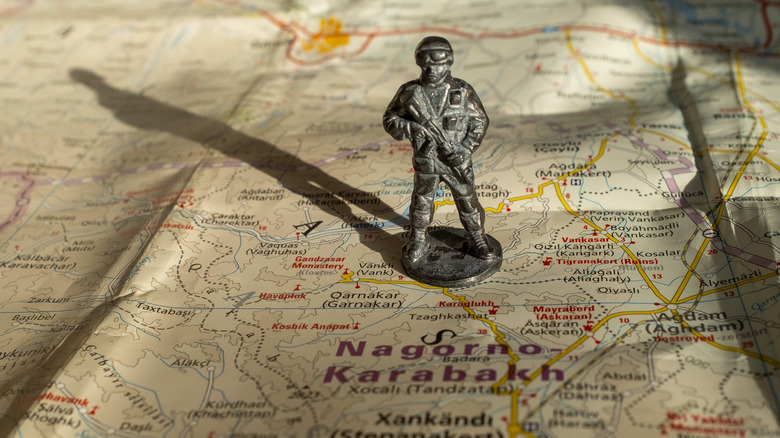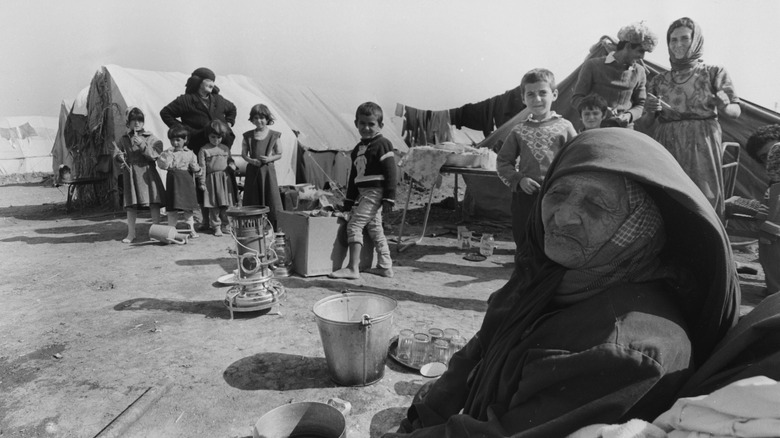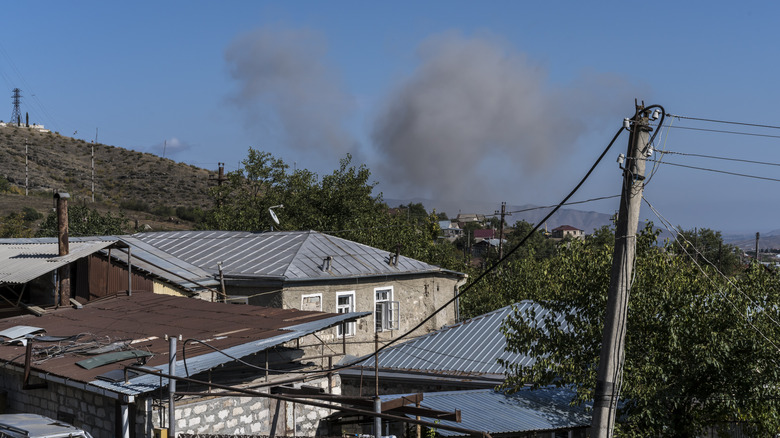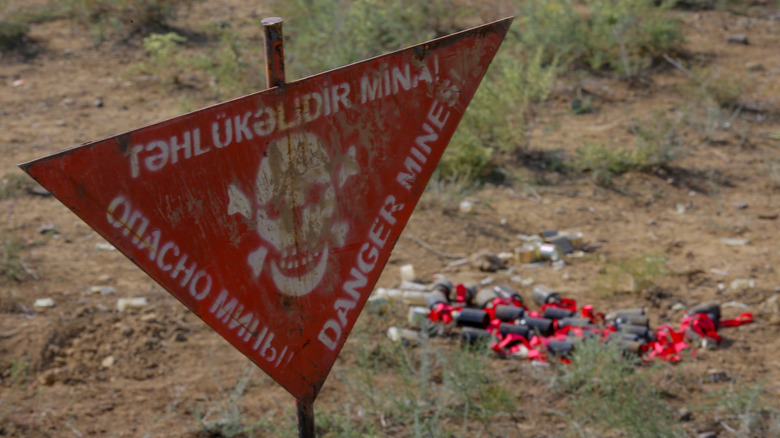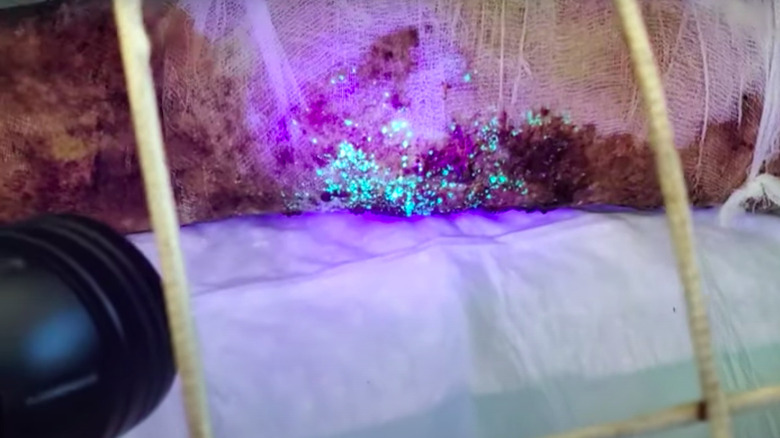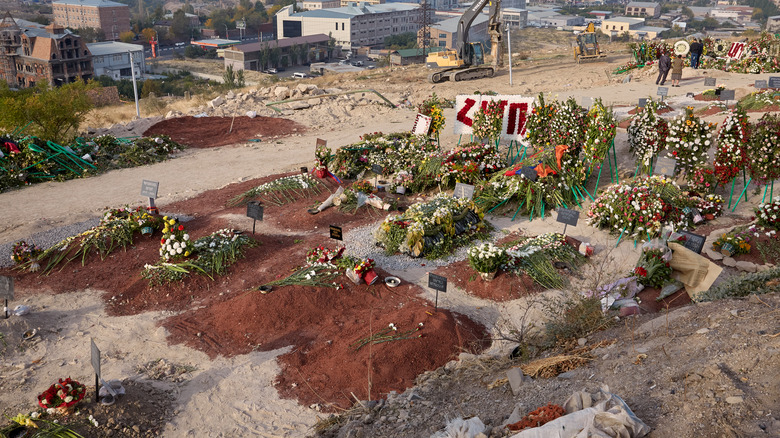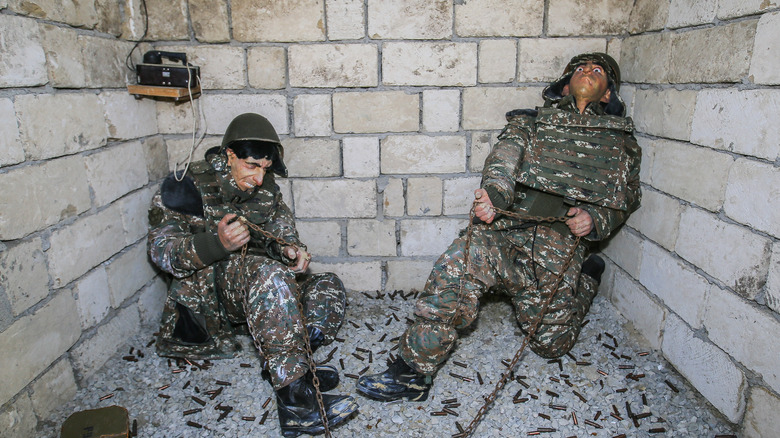What Really Happened During The 2020 Nagorno-Karabakh War?
Less than one year after the Second Nagorno-Karabakh War started in 2020, Armenia filed a lawsuit against Azerbaijan at the International Court of Justice at The Hague. According to Associated Press, Armenia alleged that due to a "state-sponsored policy of Armenian hatred, Armenians have been subjected to systemic discrimination, mass killings, torture, and other abuse."
Six days later, Associated Press went on to report that Azerbaijan also filed a lawsuit against Armenia at the International Court of Justice, accusing Armenia of "ethnic cleansing, cultural erasure and fomenting of hatred against Azerbaijanis." Both countries accused the other of breaching the international convention "aimed at eradicating discrimination," a convention which both countries have signed.
While it's unlikely that either of these lawsuits will resolve anytime soon, it's worth taking a look back at the war that led to their filing. Notably, Associated Press reports that Armenia said Azerbaijani soldiers have been violating the territorial integrity of Armenia since May 2021. In addition, there are allegations that murder and torture have continued despite the ceasefire that came into force on November 10, 2020. Here's what really happened during the 2020 Nagorno-Karabakh war.
A brief history the First Nagorno-Karabakh War
After the breakdown of the Soviet Union in 1991, the Republic of Artsakh, then known as the Autonomous Republic of Nagorno-Karabakh, announced its intention for independence on September 2, 1991. And January 6, 1992, the Republic of Nagorno-Karabakh officially declared its independence. But even before the official declaration, Azerbaijan launched a bombing campaign on the region in retaliation. Human Rights Watch reports that bombing began around the capital, Stepanakert, as early as July and continuing through the winter into 1992. The outlet describes Azerbaijani shelling and bombing as "reckless and indiscriminate, and aimed at terrorizing and forcing out Armenian civilians."
The newly independent Republic of Armenia fought alongside Artsakh, and by the time a ceasefire was brokered by the Russian Federation in May 1994, roughly 8.9% of Azerbaijani territory around the original Karabakh republic was occupied by Armenian forces. Although the exact number of refugees and internally displaced people is unknown, it's estimated that the First Nagorno-Karabakh War displaced more than half a million Azerbaijani people and up to 400,000 Armenian people, National Geographic reports. It's also estimated that up to 30,000 people lost their lives as a result of the First Nagorno-Karabakh War, per Reuters.
The bombing of Stepanakert
Around 7 a.m. on September 27, 2020, Azerbaijan launched an offensive along its border with the Republic of Artsakh, known as the Line of Contact. By 8:40 a.m., Azerbaijan also launched an aerial attack, bombing several towns, including the capital Stepanakert, according to the EVN Report. By noon, Artsakh's President Arayik Harutyunyan declared martial law, as did Armenia's President Nikol Pashinyan. According to the European Asylum Support Office, martial law was also declared in some areas of Azerbaijan.
In response to the shelling, Armenia's defense ministry claimed that it was able to bring down two Azerbaijani helicopters and three drones. Against this, Azerbaijani's defense ministry claimed that they were launching a "counteroffensive to suppress Armenia's combat activity and ensure the safety of the population," per Al Jazeera. By the end of the first day, Artsakh authorities reported that 16 soldiers, one civilian woman, and one child were killed, and 100 people were injured. Azerbaijani authorities reported that five people of the same family were killed by Armenian shelling.
The use of cluster munitions
Throughout the war, both Armenian and Azerbaijani forces used cluster munitions, which are known for scattering "bomblets" — or submunitions — over a large area. And according to Amnesty International, it's estimated that up to 20% of the bomblets scattered by cluster munitions don't explode and pose an additional threat to civilians after being left behind. In Mila Babayan's garden alone in Kaghartsi, Artsakh, 32 unexploded shells were found, per The Washington Post.
The Armenian side was reportedly using Soviet Smerch rockets, per Human Rights Watch. Meanwhile, Azerbaijan was reportedly using an Israeli-manufactured M095 dual-purpose submunition, writes Liberation News. Both Armenia and Azerbaijan denied the use of cluster munitions. And although over 100 states have signed the Convention on Cluster Munitions (CCM) — an international treaty banning the use and production of cluster munitions — neither Armenia nor Azerbaijan are signatories of the treaty.
According to Geneva Solutions, it's estimated that at least 360 civilians around the world died from cluster bombs in 2020, with roughly one-third of the casualties occurring in connection to the 2020 Nagorno-Karabakh war.
The use of incendiary weapons
In addition to cluster munitions, Azerbaijan also used incendiary weapons to start fires. There have been numerous claims that white phosphorus was used, while others claim that thermite was used, per the Conflict and Environment Observatory. Either way, incendiary weapons cause horrific wounds of all kinds. Indeed, the use of incendiary weapons resulted in serious burns on Armenian soldiers. EVN Report writes that French doctors who treated the burn victims noted that the wounds were especially "difficult to heal" compared to typical burns. The seeming presence of phosphorus can be shown using ultraviolet light, as shown by Zartonk Media. According to the International Journal of the Care of the Injured, at least nine Armenian soldiers died following hospital admission as a result of their burns.
The Azerbaijan Ministry of Foreign Affairs also claimed that Armenia was using white phosphorus during the war, but their only evidence was an unexploded munition. Meanwhile, Artsakh's forests were also reportedly targeted by Azerbaijani forces, and hundreds of hectares of woods were burned. According to the European Asylum Support Office, there were reports of almost 2,000 hectares of forest — over 7 square miles — being burned down due to Azerbaijani's shelling with phosphorus weapons.
Beheadings and torture
Throughout the 2020 Nagorno-Karabakh war, numerous videos were shared on social media and Telegram groups showing soldiers abusing prisoners of war and civilians. Amnesty International reportedly verified the authenticity of multiple videos, including clips of the decapitation of an Armenian civilian while still alive and the execution of an Azerbaijani border guard. Soldiers on both sides are accused of desecrating dead bodies, though this ranges in severity from Armenian soldiers cutting off the ears of dead Azerbaijani soldiers to Azerbaijani soldiers playing with the decapitated head of an Armenian civilian and a pig's carcass.
Although Azerbaijan claimed that they didn't use Syrian mercenaries, BBC reports that there's considerable photographic evidence to prove the use of mercenaries that were essentially used as "cannon fodder." Numerous Armenian POWs and civilian detainees were also captured by Azerbaijani during the war. And although some have been returned (per Reuters), many remain in Azerbaijani custody and have been subjected to torture, according to Human Rights Watch. Since the end of the war, Azerbaijan has also been holding and torturing hundreds of Armenian POWs and civilian captives. Eurasianet reports that while some have been used as bargaining chips, others are undergoing sham trials and receiving up to 20 years in prison, per OC Media.
The capture of Shushi
After several missile strikes at Shushi by the Azerbaijani military around the beginning of November, there was an Azerbaijani offensive to take the city. The fighting reportedly went on until a cease-fire was agreed upon on November 9, 2020, according to the European Asylum Support Office. The end of the conflict was seemingly abrupt, and even Al Jazeera described the cease-fire deal as "hastily signed."
As a result of the Second Nagorno-Karabakh War, Azerbaijan not only regained the territories that Armenian forces had claimed during the 1991-1994 conflict, but they made territorial gains into the original borders of Nagorno-Karabakh. As a condition of the cease-fire, Russian peacekeepers were deployed to what remains of Artsakh, although their mission and mandate are "vague," per EVN Report. There were also reports that Turkey's parliament also approved the deployment of Turkish peacekeeping forces, but it's unclear if they were ever actually deployed to the region, Warsaw Institute writes.
Almost 3,800 Armenian soldiers (via RFERL) and nearly 2,800 Azerbaijani soldiers (per Reuters) were killed during the fighting. At least 146 civilians also lost their lives, per Amnesty International, and injuries and missing people number in the tens of thousands. In addition, over 100,000 people were displaced.
After the war, Azerbaijan also created a war museum known as the Spoils of War Park, featuring caricatured mannequins of Armenian soldiers. In its lawsuit, Armenia alleges the mannequins were "presented in degrading and humiliating positions with exaggerated, Armenophobic features based on anti-Armenian tropes."
